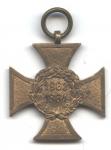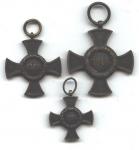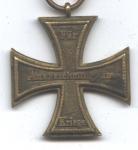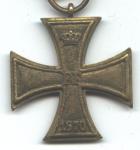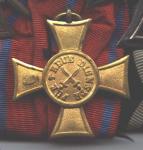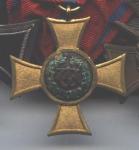-
Posts
785 -
Joined
-
Last visited
-
Days Won
4
Content Type
Profiles
Forums
Blogs
Gallery
Events
Store
Everything posted by Schießplatzmeister
-
Hello Chris: I believe that the first award was a Saxon Civil Merit Order, 2nd model, Knight's Cross 2nd Class with swords, next would be a Saxon Albert Order, Knight's Cross 2nd Class with swords. Both of these were of course WWI award pieces to a junior Officer and would be made of silver/silver-gilt. Yes, you are right, now an expensive proposition to find these. There was a time....when no one cared about Saxon awards and they could be had cheaply (my first Albert Order 2nd Class Knight cost $60!!!). I have seen the Civil Merit Order knight's badges go for CRAZY prices lately in Germany. The book by Arnold, Keil, and Weber really caused a price spike in recent years, along of course with the bettering of the economy of Saxony as it got farther away from the times of the DDR. You are looking at easily over $600 to restore it (and this is a relatively conservative figure). A very nice bar by the way, with original ribbons, and well worth the restoration effort. Be patient, the right pieces will come along at the right price. Oh, I long for the "old days" with cheaper prices! Best of luck! "SPM"
-
Ding, ding, ding, ding, ding! Yes folks, we have a winner! Hats off to Rick Research! The tag on the back of the ribbon bar has "Max Weise/ GERA/ TEL...(unreadable)". You have convinced me beyond any doublt that this is v. Lorck's ribbon bar. I am very grateful for the information that you have provided! You will be most welcome to utilize the piece for publication. A PM will follow. Thanks, "SPM"
-
[attachmentid=26529] Hello again: Just so I don't tick off Stogieman and Rick Research, I have included a scan of the reverse. The maker's tag is for "Max Weise". The moths had a nice snack on the backing at some point in the past! This piece came from a Russian ex-pat from an accumulation out of Russia. So, it was probably a WWII Soviet "vet pick-up/bring-back". "SPM"
-
[attachmentid=26528] Hello folks: Here is an example of a fellow who added his Johanniter Orden to his ribbon bar. This is the only one like it that I has seen until now. So Heiko, this is definately possible for a ribbon bar, although not proper. This is probably what the black ribbon is on your ribbon bar. This must not have been too uncommon as someone was making devices for this Order for the ribbon bars. Thanks, "SPM"
-
[attachmentid=26522] Hello folks: Here is a W?rttemberg Landwehr Service Award 1st Class. These were awarded from 1891 until 1921. The cross has a silver body and a separate center which is made from gilded-silver. These pieces are a lot less common than the OEK price would indicate. The reverse center has "XX" in the center for twenty years of service. The reverse is made of one piece of silver and has no gilding. These crosses were apparently awarded to Landwehr Officers and doctors with an acceptable amount of service time. Thanks, "SPM"
-
Hello again folks: Sorry, I just can't leave this topic alone! I will now use "SPM" as my moniker to make everyone's life a bit easier when I write. A bit more digging in Hessenthal u. Schreiber reveals the following information. The terms "gepr?gten", "Pr?gung", "Gepr?ge" are all used when mentioning the Mecklenberg-Schwerin crosses from 1848 until 1914. This literally means "struck" or "coined" as in die-struck. They use the same terminology when describing the Bavarian 1866 campaign cross however, and those were in my opinion without a doubt cast. I believe that they used the term for everything unless they knew for certain that a piece was made by casting (i.e. cast iron pieces). We must remember that this text was published in 1940 and much of the information regarding the awards of the pre-1918 states was probably even difficult to find at that time as many years had elapsed since the Kingdoms, Grand Duchies, Duchies, etc. had ceased to exist. Interestingly enough, H. u. S. state on page 237 "Die Milit?r-Verdienstkreuze mit den Jahreszahlen 1848, 1849, 1859, 1864, 1866 sind bei sonst gleicher, ziemlich primitiver Ausf?hrung aus Gesch?tzbronze hergestellt". So, "primitive pieces made from cannon-bronze" apparently were noted for the 1848-1866 pieces. Now, the question for the 1870 pieces remains. Were there cast crosses made from cannon-bronze which are contemporaryily issued pieces? Are die-struck examples which are old possible? I believe that the answer to both of these questions is "yes". I also believe that all forgeries, counterfeits, etc. are certainly cast also. Sometimes, the more information one seeks, the more questions one has! Thanks Stogieman and Brian for your input! "SPM"
-
Hello Stogieman: Thanks for your comments. Yes, I agree, there are a few details of the 1870 FF cross that you sent back which look suspect. The suspension lug at the top is crude to the extreme. The stippling of the fields of the cross body also doesn't look proper. It is probably a counterfeit made to deceive collectors. The context with the highly suspect non-1870/71 issue EK is also another troubling factor. It was a good move sending it back. The 1870 FF cross that I have is not "pretty" at all either. In fact, I think that there are modern forgeries which look much nicer. I do think that it is genuine in spite of/ because of its ugliness. When it comes to these, I believe that all forgeries were cast, but that not all castings are forgeries. We are in full agreement. If you could see the piece that I have in person, I think that you would probably lean toward it being genuine. The context in which I picked it up was good and it looks nothing like the recent copies that were flowing out of Germany. I would like to see if there is anyone else out there who has original examples of these, or information about their manufacture. Sorry, to flog the dead horse, but I find the topic fascinating. Thanks for your patience Stogieman et al! Schie?platzmeister
-
[attachmentid=26384] Hello again everyone: Here are a few examples of campaign crosses which are all original and were made by casting. All of them have suspension lugs which were an extension of the casting of the body of the crosses. First, here is a "family" of Bavarian 1866 campaign crosses. Thanks, Schie?platzmeister
-
Hello again: By comparison, the 1914 cross that I have is definately genuine and I believe that it is also cast in one piece with the arm edges being ground and polished to finish it. I simply think that this is how these things were made. Die striking would not be necessary to make these and would add many extra and more expensive steps to the manufacturing process. Hessenthal and Schreiber refer to the 1914 pieces as being made from "gilded cannon metal". Thanks, Schie?platzmeister
-
Hello Stogieman: Thanks for your comments. I agree that you should have returned the pieces that you show as they do not look like period pieces. My cross has the suspension ring soldered to the top of the cross. Hessenthal and Schreiber state that the crosses were made from gesch?tzbronze (cannon bronze from captured enemy cannon). They do not however state HOW they were made. In my opinion, the originals were cast in one piece as this would be consistant with the technology of the time, and there are crosses from many other German States from this period to show that this was a common practice for making such crosses out of gesch?tzbronze. Perhaps my piece is a forgery, but I do not think this the case (of course I am not impartial-no one thinks that THEIR stuff is ever fake!). Of course, all of the copies (no matter what age) are also made by casting! So, obtaining genuine pieces is difficult to say the least, with most pieces which are encountered being modern counterfeits. The mystery continues. Does anyone else have any of these, or any other information? Thanks, Schie?platzmeister
-
Hello David: Dr. v. Hessenthal u. Schrieber list the following: 482. Gold medal awarded 1840-1843, marked "BRANDT F.", 50mm, name of recipient engraved on rim 483. Silver medal awarded 1840-1843, marked "BRANDT F.", 50mm, " 484. Gold medal awarded 1843-1846, ", ", " 485. Gold medal awarded 1846-1847, marked "FICKENSCHER", ", " 486. Gold medal awarded 1847-1866, maked "BREHMER F.", ", " Of course there are more details listed regarding design, suspensions, ribbons, etc. Perhaps Wildcard is out there and could provide photos of some of the above-listed pieces. As far as recipients are concerned, perhaps someone out there has Hannoverian Court and State Handbooks from this period which probably list recipients. I hope that this helps, Schie?platzmeister
-
[attachmentid=26038] Finally, here is a view of the piece and the non-combat ribbon. It looks much better in hand than in my poor quality scans. The piece was made from a single casting and the edges were ground to finish it. I have seen a LOT of copies of these pieces with various dates (and no date) come out of Germany in the past few years. Genuine pieces are not that common as Mecklenberg was a rather small Grand Duchy. Thanks, Schie?platzmeister
-
Hello folks: Yes, this bar seems VERY wrong. I don't believe that a Bavarian would wear his bravery medal behind his MVOVKIIm/schw., and ESPECIALLY not behind an EKII. It makes no sense anyway one looks at it, yet it does look like an older mounting in typical Bavarian fashion. Also, the Saxe-Meiningen medal should not appear with the Bavarian items (I can't remember ever seeing this). Strange (???). Schie?platzmeister
-
[attachmentid=25841]Hello folks: Here is a photo of the obverse of the 1892-1918 Officer's 25 Year Service Cross. Notice that the "W" does NOT have enamel (my earlier comment was erroneous) and the wreath DOES have green enamel. The center of the cross appears to be made of silver judging by the patinae and it is definitely a separate piece. The cross arms are finely stippled and the raised edges of cross arms are polished. Schie?platzmeister
-
Hello again: An active duty officer would definately receive a 25 year service cross if he had the proper amount of total time in service. This cross was made from gilded-bronze, and had a "W" (with green enamel) for King Wilhelm II surrounded by a wreath on the obverse center medallion. Is there anyone out there that can post a photo/scan of this piece for Stijn? Stogieman, I am sure that you could add a lot here regarding what combinations of service time could lead up to an officer's 25 year service award (reserve, active, combat, etc.). There may already be another thread which covered the Prussian regulations which were probably analogous to those for W?rttemberg. Thanks, Schie?platzmeister
-
Hello everyone: The nine (9) year service medal was awarded to enlisted soldiers. This medal was made from iron and it should be magnetic. The 1913-16 pieces are made from argentan (a silver-coloured, non-silver alloy). As the war progressed, the Kingdom of W?rttemburg (and other German states) stopped using more valuble metals for these pieces and switched to iron which was more common (less-needed for war-related production) and cheaper. I hope that this helps! Schie?platzmeister
-
Hello everyone: I too saw this photograph on Ebay. I recently read a few very interesting articles posted on the internet regarding American black men who had escaped slavery during the Revolutionary War and were recruited by Kurhessen regiments as drummers. Apparently it was a status symbol for a regiment to have a black drummer as their skills were highly prized. According to the article, Prussian regiments of the time also followed this tradition. It is interesting to see that this tradition stayed around for awhile. Thanks, Schie?platzmeister







